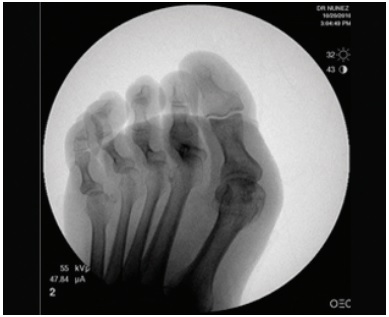Download and print as a PDF (265kB pdf)
On this page
What are hammer and mallet toes?
Your toe contains two joints that allow it to bend at the middle and the end. A hammer toe occurs when the middle joint becomes fixed in a downward position (flexed). A mallet toe occurs when the end joint is fixed in a downward position.
Some causes of these deformities are tightening of ligaments and tendons of the foot, arthritis, toe injury and bunion. Symptoms can include pain when walking, an inability to move the toes, corns and callouses. It is when these symptoms become too difficult to manage that surgical intervention is considered.
What happens during surgery?
There are a number of different surgical techniques used depending on the level of toe deformity. An osteotomy (the cutting of a bone to re shape it through healing) can be made to the relevant toe joint. Ligaments and tendons may be released (cut) or a suture (stitch) could be used to hold the toe in position.
There are a number of reasons why a minimally invasive technique is preferred by some surgeons; a possible reduction in the risk of infection and pain, a quicker recovery period due to reduced tissue trauma and a reduction in joint stiffness. The aim of this surgery is to straighten the toes through correcting the alignment.

What happens after surgery?
You will have your surgery at the Sussex Orthopaedic Treatment Centre (SOTC). This is usually done as day case surgery using either; regional anaesthesia (regional nerve block) that numbs your leg, or a general anaesthetic.
After your surgery you will have a bandage on your foot. The aim of the bandage is to support your toes in their new position while the bones in your foot are healing. This will be changed at your 2 and 6 weeks follow up appointments.
The recovery staff will give you an orthopaedic flat shoe to protect your foot. You will be wearing the flat shoe for 6 weeks at all times when walking.
You will able to put all your weight through your foot immediately after your surgery, and be given a pair of crutches to help with your walking. These are to be used for the first 2 weeks after your operation, then to be used as necessary. We would encourage you to discard the crutches by your 6 week follow up appointment.
During the first 2 weeks after your surgery we advise you to elevate your leg as high as you are able and to apply ice if required. Elevation and icing of the foot will help to reduce the swelling. The swelling can be expected to last for between for 3-6 months. Please walk regularly for short periods.
Two weeks after surgery
At 2 weeks you will have a post-operative wound check with a nurse who works in Mr Vernois’ team.
Your bandage will be removed and the surgical wound/s assessed. The nurse will then re-apply your bandage as per Mr Vernois’ post-operative instructions.
Do not get this dressing wet in any way as this can cause complications to your surgical wound.
Six weeks after surgery
At your 6 week follow up appointment you will see a nurse from Mr Vernois’ team and have an x-ray taken.
Your dressing will be taken down and your surgical wound/s will be reviewed. We would expect these to be healed by this time. You will not need a further dressing at this stage.
The nurse will discard your orthopaedic shoe, the bones in your foot will have healed enough to walk on without it. Please bring suitable footwear with you to change into. A firm but pliable sole with forefoot coverage is recommended.
You will be shown exercises that will help you to loosen your toe joints and increase their range of movement.
You can start to drive and resume low impact sports after this appointment.
Three months after surgery
At this stage you will have an appointment with Mr Vernois. An x-ray of your foot will be taken and this will be reviewed. You will then be discharged from his care.
High impact sport can be resumed after this appointment.
This information is intended for patients receiving care in Brighton & Hove or Haywards Heath.
The information here is for guidance purposes only and is in no way intended to replace professional clinical advice by a qualified practitioner.